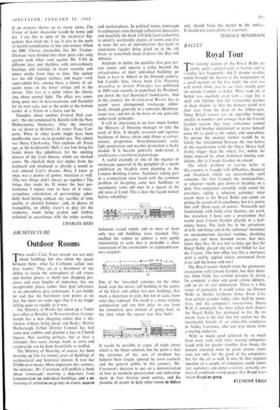BALLET
Royal Tour
THE touring section of the Royal Ballet re- cently spent a glacial week at Sutton, and so —rather less frequently—did I; despite weather which brought the theatre to the temperature of a good martini on the first night. the visit was well worth while, just to see what exactly goes on outside London as ballet. What went on at Sutton was excellent, even with a stage like a shelf and lighting that left fascinating patches of deep shadow so that the dancers could rest their eyes from the glare of the follow-spot. These Royal tourers arc an appealing troupe; smaller in numbers and younger than the Covent Garden section, they have sometimes seemed like a kid brother determined to prove himself every bit as good as his senior, and succeeding. To pursue the analogy further would be to falsify the relationship between the two halves of the organisation (with the Opera House half Irishly bigger than the other), for, within the limits imposed by often diabolical touring con- ditions, this is Covent Garden on circuit.
The whole problem of touring ballet in this country is fraught with difficulties, financial and theatrical, which are unresolvable until someone—the Arts Council, the municipalities, or whoever—really gets down to deciding on a plan. Five companies currently rattle round the provinces, ogling a reluctant audience; what cream there is the Royal Ballet can count on getting by reason of its excellence, but it is pretty thin stuff. Dates vary, of course: Newcastle and Sunderland, with lively civic theatres, are good, but elsewhere I have seen a programme that would pack Covent Garden playing to a half- empty house. The fault lies in the attractions of telly and bingo and in the audiences' insistence on unadventurous classical routines, involving peasants and those damned swans, that they know they like. (It was not so long ago that the Royal Ballet played one city and billed Le Lac des Cygnes. The box office was like a mortuary until a swiftly applied sticker announced Swan Lake and the house sold out.) The Royal tourers benefit from the glamorous association with Covent Garden, but their direc- tor, John Field, has worked miracles in giving his company a clear and good artistic identity, and an air of real enthusiasm. There is a fine roster of principals (I would rather see Doreen Wells or Shirley Grahame dance Swan Lake than certain grander ladies, who shall be name- less), and the company's wunderkind, David Wall, is potentially the most gifted male dancer the Royal Ballet has produced so far. By no means least is the fact that the section has the inestimable benefit of an admirable conductor in Ashley Lawrence, who can urge music from a touring orchestra.
With so much good achieved by so much hard work (and with other touring companies faced with far greater troubles than these), the present situation must be given serious atten- tion, not only for the good of the companies, but for the art as well. It may be that regional location of a couple of companies could stimu- late audiences and dance creation; certainly im- provzd conditions could ensure that Royal tours meant Royal progress.
CLEMENT CRISP


































 Previous page
Previous page